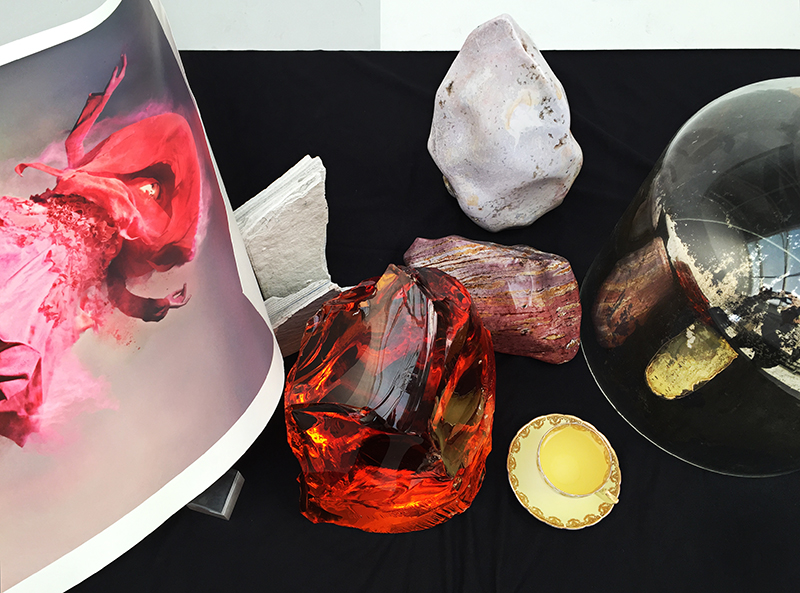

"I wasn’t that concerned that photography died and changed; it’s part of the ongoing process of making imagery.”
In 1997 Nick Knight took one of the most striking fashion photographs ever: the model Devon Aoki as a frightening monster dressed in flowery Alexander McQueen, with one of her eyes glowing blue and blossoms pouring from her slashed forehead. Already he was trying all sorts of digital trickery and tearing at the edges of what a photograph could become.
Soon after that, in 2000, he launched his online fashion film platform SHOWstudio, with the intention of “showing the entire creative process from conception to completion” and of opening up his image-making studio to the world. It involved not only him but included his favourite creatives. One project, in 2004, saw him collaborating with Heston Blumenthal on a lavish, experimental banquet; a kingly feast of oyster jellies and snail porridges which was used for a fashion shoot while its dinner guests’ conversations were recorded and released online. Another project, in 2013, involved the use of 3D scanning and motion capture to make an interactive music video for Kanye West. The result was a nightmarish Vorticist vision jumping at the screen, trying to escape from the computer. Nick Knight himself is like a Blumenthal, like a West, in his relentless experiments with form.
Today the internet has replaced magazines and newspapers as the platform through which most of us experience images. “That’s where people see them, and that’s where people interact with them, and that’s where people cherish them,” Knight says. “I think one has to realise the momentousness of that new relationship between art and its audience.” For him what is most exciting about this new relationship is the unparalleled freedom that it offers. Now everybody is able to publish their own work imagery without needing the prior approval of an editor, say, or a gallery. Not only that, but because there is no longer a third party trying somehow to profit from the distribution of that imagery, the focus is usually on creative expression rather than on making money. Like many projects, SHOWstudio was created out of frustration. Knight felt his favourite designers were not represented well enough in the fashion press and that magazines were unwilling to publish the images he really wished to make.

“You talk among your peers and everybody says ‘My best picture was killed’ or ‘They wouldn’t let me do a story on this’,” he explains. And, I thought; ‘Well I’d love to have that out there’. I started it really as a way to express myself and to let people whose work I liked express themselves. “SHOWstudio was started for the love of the art,” he continues. This is one of the important things that sets it apart. It’s an experimental platform funded by a fashion image-maker. Knight already had commercial clients when he launched the platform, and that allowed him the financial freedom to set his wildest ideas free on it. While many fashion magazines in London started out as independent trailblazers and are now in the process of turning themselves into branding agencies of sorts, SHOWstudio is swimming against the current.
But the most radical transformation in the industry is happening not to magazines but to runway shows. “This is fundamentally changing the relationship between the audience and the designer. The system isn’t exactly in place – yet. But increasingly it’s looking towards the fact that as soon as the first model hits the catwalk, you’ll be able to buy the dress she’s wearing. So then the designer has to think: ‘OK, this is the moment I have to make my clothes look most beautiful’. And that changes the nature of the fashion show.”

Today, of course, shows are mostly experienced online: through catwalk photography, through live streaming, through Instagram snaps. Even those attending shows often sit capturing everything on their phones. And the most important moment in this opening up of fashion shows from hidden, secretive happenings into flamboyant extravaganzas was surely SHOWstudio’s collaboration with Alexander McQueen on the outstanding production of Plato’s Atlantis.
The 2009 show was tragically the designer’s last, and it had huge, menacing robots roaming up and down the side of the runway, following the models, filming their every movement, then swivelling sinisterly around and filming the front row. “Alexander McQueen had basically turned the show into a spectacle that was broadcast across the internet,” says Knight.
Lady Gaga, he adds, had launched her Bad Romance single at the show, with the models walking down the catwalk at the end to that soundtrack. Lady Gaga fans, he continues “watched the show live online – which had a slightly detrimental effect to our streaming capabilities. Yet something that was previously going out to 20,000 people at the time (and that would have been on a good day) went out to six million people. All those little monsters probably had no idea who Alexander McQueen was and were yet to learn of any of his amazing, eye-catching ideas or of the vision he was proposing. But all of a sudden, when they went to hear Lady Gaga’s single, they saw this and it opened up their eyes to a lot of things.” He explains this with blunt honesty: “If you can get through to six million people in one show for 15 minutes, you really need to spend your money on that, not on an advertising campaign in magazines that people don’t buy.”
"There isn’t a designer alive who creates a piece of clothing to be seen from one angle only” Of course the fashion industry adores novelty and change; the very idea of change is what drives it forward. Brands enjoy innovation, from Fendi sending drones with cameras down its catwalk and getting them to hover over Cara Delevingne like cherubs, to Burberry having pop stars performing, or creating a downpour of fake rain from cloud bursts over its catwalk. And they need innovation if they’re to stand apart from their competitors. According to Knight “to turn the show into some completely different version of a catwalk event which is accessible to the public, which is entertaining, which is must-see viewing, that’s much more where it’s going to go”.
So inside SHOWstudio’s light-filled offices at a beautiful townhouse in Knightsbridge, the latest technologies are embraced with aplomb, from producing an augmented-reality editorial magazine for Garage in which a bespoke app brings an unsettling horror story out of thin air and on to the page, to live streaming the 3D-capture of Victoria’s Secret Angels for the covers of 10. Knight’s young team can present online broadcasts, record eerie sound installations, sculpt complex computer animations – all the sorts of skills that you won’t find in-house at other fashion platforms – so everything is in place for the production of innovative fashion films at the drop of a hat. “When a designer creates a piece of clothing it’s always to be seen in movement. There isn’t a designer alive who creates a piece of clothing to be seen from one angle only,” says Knight. “Fashion film is actually just about fashion moving. You don’t need to set it up with a narrative like a Hollywood film, you don’t need Wes Anderson to direct it ... This is a medium that can be used on your iPhone. This is just about clothes moving.”

Indeed, throughout his career Knight has been an advocate of lo-fi aesthetics as much as of polished perfection. Recently he used his phone to shoot the stills campaign for Nicola Formichetti’s first collection for Diesel, and he mostly used the apps Mega Photo, Instagram and Glitché to coat his models in dripping digital paint and bright colours. This, obviously, was a counterintuitive move in an industry that often spends millions on its advertising campaigns. It was a popular one, too.
However SHOWstudio itself carries no advertising, and this has helped maintain its authenticity and its credibility. Everybody involved can speak without any bias, especially in its notoriously harsh reviews and its live-stream discussions about the latest catwalk collections, with industry insiders taking apart the shows exactly as they happen. While SHOWstudio likes to push boundaries artistically and technologically, it also likes to stir things up.
“Any art form, be it opera or literature, needs a good, critical forum, and fashion previously hasn’t had that,” says Knight. “I’ve chosen not to have advertising because I don’t want to fall into the trap that magazines have fallen into where they daren’t say anything. So we critique shows; and we get in trouble for doing it; and we get banned from shows; and we get the PR saying, ‘How dare you say that’.”

What of the future? The latest innovation from SHOWstudio is the launch of its e-commerce platform in collaboration with Soho boutique Machine-A, which offers clothing, accessories and artworks from the more daring pockets of the fashion world. The focus, certainly, is on selling the hottest up-and-coming talents rather than the grand old ateliers, and also allowing them a louder voice online. “You can go and you can see a fashion film by a designer, you can listen to an interview with that designer, you can read articles about how their clothes are being considered, and you can buy their clothes,” explains Knight. “So that kind of makes it almost a full circle.”
Many online fashion retailers today, from vast, corporate Net-a-Porter to cool upstart VFiles, are blending editorial and sales together on their sites in order to promote the collections they offer and also to keep customers returning day after day. By offering very experimental visuals alongside outspoken opinions, by having an online selling space and by also having the ability to help produce runway shows and advertising campaigns, SHOWstudio is unique. Really it’s the closest thing we have to a complete platform for fashion today. And although it cannot sell clothes straight off the catwalk – nobody can, not just yet – that’s likely to come sooner rather than later. Knight cannot wait. In this, as in most things, he is looking towards the future and wondering how he can help create it.
“There’s a huge shift towards a much more democratic feeling in fashion,” he says, dreaming of the coming day when most campaigns and catwalk shows will be transformed into astonishing online spectacles that everybody can experience, when collections will be available to purchase right away, straight off the runway, allowing designers to see exactly what their fans want and respond. “Before, it was very much behind closed doors, that’s just how the system worked,” explains Knight. “But the system is now different and therefore, because it is different, it needs different ways to express itself.”
Photography by Jon Emmony



Discussion